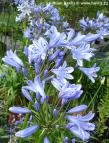Agapanthus 'BLUE GIANT'

Agapanthus 'BLUE GIANT'
African blue lily
African blue lily
| SIZE/TYPE | mid-sized perennial |
|---|---|
| USUAL HEIGHT | 0.8-1m |
| USUAL WIDTH | |
| LEAVES | deciduous broadleaf |
| COLOUR OF LEAVES |
 green green |
| FLOWERS | showy |
| COLOUR OF FLOWERS |
 indigo blue indigo blue
|
| BLOOMING TIME | July - August |
| LOCATION | full sun |
| USDA zone (lowest) | 6 (down to -23°C) |
| WINTER PROTECTION | |
| FOR ZONE 5+6 |

|
| FOR ZONE 7 |

|
| BELONGS TO CATEGORIES |
Perennials Summer blooms |
African blue lily is one of the most attractive summer plants. This perennial is from southern Africa where less hardy species are grown. We are very lucky to have good breeders here in Europe. They made several hybrids most of which have not only nicer flowers but are hardier than the species and can grow and flower freely in climate zones where some people still think that magnolias cannot survive.
We are offering an agapanthus variety that tells everything in the name: Blue Giant. It makes upto 1m tall stalks with rounded umbels of sky-blue flowers. The individual flowers are trumpet-shaped and have deep blue stripes. When fully opened they look like blue stars. Strap-like leaves are about 2-3 cm wide and mid green. Blue Giant blooms in mid-summer: July-August.
Grow agapanthus in fertile, very well-drained soil. In too wet or boggy soil it will most certainly die. The plant benefits from regular watering and fertilizing from spring until end summer. Though, once established it withstands drought. In the Mediterranean it belongs to the top favourite summer blooming plants. I even saw them planted at motorways near Nice. Whether they were irrigated there or not does not matter so much as I noticed many more of them grown freely in gardens with no irrigation, just absorbing moisture from humid sea-coastal air.
Winter care in our climate: you can cut off all leaves about 5-7cm above ground, or – which is better – bend the leaves across the centre of plant down to the ground and cover with about 20 cm of DRY mulch. Put a waterproof cover on top of the pile but make sure you leave about one third around the edge free so that the pile can breathe. Such protection will ensure surviving -20°C or lower. At the end of winter, after danger of severe frosts remove the waterproof cover and in spring when the temperature gets warm remove all mulch and cut off all leaves so that the plant can start growing again.
Last update 11-07-2008
We are offering an agapanthus variety that tells everything in the name: Blue Giant. It makes upto 1m tall stalks with rounded umbels of sky-blue flowers. The individual flowers are trumpet-shaped and have deep blue stripes. When fully opened they look like blue stars. Strap-like leaves are about 2-3 cm wide and mid green. Blue Giant blooms in mid-summer: July-August.
Grow agapanthus in fertile, very well-drained soil. In too wet or boggy soil it will most certainly die. The plant benefits from regular watering and fertilizing from spring until end summer. Though, once established it withstands drought. In the Mediterranean it belongs to the top favourite summer blooming plants. I even saw them planted at motorways near Nice. Whether they were irrigated there or not does not matter so much as I noticed many more of them grown freely in gardens with no irrigation, just absorbing moisture from humid sea-coastal air.
Winter care in our climate: you can cut off all leaves about 5-7cm above ground, or – which is better – bend the leaves across the centre of plant down to the ground and cover with about 20 cm of DRY mulch. Put a waterproof cover on top of the pile but make sure you leave about one third around the edge free so that the pile can breathe. Such protection will ensure surviving -20°C or lower. At the end of winter, after danger of severe frosts remove the waterproof cover and in spring when the temperature gets warm remove all mulch and cut off all leaves so that the plant can start growing again.
Last update 11-07-2008
SIZES and PRICES
CURRENTLY SOLD OUT
GLOSSARY
|












